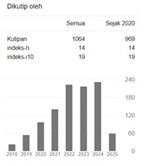EKSPLORASI KETERAMPILAN MATEMATIKA YANG MEMPENGARUHI KEMAMPUAN NUMERASI SISWA SEKOLAH DASAR
Abstract
This study aims to explore the skills that students need to develop in order to utilize mathematical knowledge in solving numeracy problems. A descriptive qualitative approach was employed, utilizing test instruments and in-depth interviews for data collection. Twenty-one fifth-grade elementary students participated in the numeracy assessment, with three subjects—representing low, medium, and high numeracy proficiency—selected for detailed interviews. Findings reveal that only students with high numeracy competence demonstrated the ability to integrate number sense, an understanding of mathematical relationships, computational skills, and information interpretation to solve numeracy tasks successfully. Conversely, students with medium and low proficiency exhibited significant difficulties, particularly in comprehending problem contexts and accurately applying arithmetic operations. Therefore, numeracy learning strategies need to integrate the strengthening of mathematical literacy and the development of conceptual understanding.
Full Text:
PDFReferences
Adinda, D. W., Nurhasanah, & Oktaviyanti, I. (2022). Profil Kemampuan Numerasi Dasar Siswa Sekolah Dasar Di SDN Mentokan. Jurnal Ilmiah Profesi Pendidikan, 7(3), 1066–1070. https://doi.org/10.29303/jipp.v7i3.700
Asy’arie, B. F., Setiadi, A. H., Firdaus, M., Mahdi, R., & Mustofa, Moh. A. (2024). Strengthening Learning Priorities in the 21st Century: Review of Islamic Education Policy in Indonesia. Tarbawi: Jurnal Keilmuan Manajemen Pendidikan, 10(02), 279–294. https://doi.org/10.32678/tarbawi.v10i02.10615
Aunio, P., & Räsänen, P. (2016). Core numerical skills for learning mathematics in children aged five to eight years – a working model for educators. European Early Childhood Education Research Journal, 24(5), 684–704. https://doi.org/10.1080/1350293X.2014.996424
Barham, A. I., Ihmeideh, F., Al-Falasi, M., & Alabdallah, A. (2019). Assessment of first-grade students’ literacy and numeracy levels and the influence of key factors. International Journal of Learning, Teaching and Educational Research, 18(12), 174–195. https://doi.org/10.26803/ijlter.18.12.11
Deda, Y. N., Disnawati, H., & Daniel, O. (2023). How Important of Students’ Literacy and Numeracy Skills in Facing 21st-Century Challenges: A Systematic Literature Review. Indonesian Journal of Educational Research and Review, 6(3), 563–572. https://doi.org/10.23887/ijerr.v6i3.62206
Dewi, D. L., & Ekawati, R. (2022). Students’ numeracy skills in solving the fourth level of minimum competency assessment question development on ratio and proportion. Jurnal Ilmiah Pendidikan Matematika, 11(1).
Fitriana, M. A., & Sukarto. (2021). Analisis Kemampuan Numerasi Dalam Memecahkan Masalah Matematika Di Sekolah Dasar. JUPE: Jurnal Pendidikan Mandala, 7. http://ejournal.mandalanursa.org/index.php/JUPE/index
Gal, I., & Tout, D. (2014). Comparison of PIAAC and PISA Frameworks for Numeracy and Mathematical Literacy (OECD Education Working Papers, Vol. 102). https://doi.org/10.1787/5jz3wl63cs6f-en
Juhaevah, F. (2022). Developing mathematics problems using local wisdom context of Maluku to improve students’ numeracy. Jurnal Elemen, 8(1), 323–339. https://doi.org/10.29408/jel.v8i1.4524
Kemendikbud. (2022). Modul Pelatihan Peningkatan Kompetensi Untuk Guru.
Kementrian Pendidikan dan Kebudayaan.
Kusumawati, N., & Pratiwi, E. (2023). Level Kemampuan Numerasi Dasar pada Siswa Sekolah Dasar. Judikdas Borneo: Jurnal Pendidikan Dasar Borneo, 5(2).
Lena, M. S., Iraqi, H. S., & Febriyasni, S. (2023). Analisis Tingkat Kemampuan Literasi dan Numerasi Siswa Sekolah Dasar. Journal of Basic Education Studies, 6(1).
Mariamah, Suciyati, & Hendrawan. (2021). Kemampuan numerasi siswa ditinjau dari jenis kelamin. Tunas: Jurnal Penelitian Pendidikan Dasar, 3(2), 93. https://doi.org/10.30651/else.v3i1.2541
Martiyono, Sulastini, R., & Handajani, S. (2021). Asesmen Kompetensi Minimal (AKM) dalam Mewujudkan Sekolah Efektif di SMP Negeri 1 Kebumen Kabupaten Kebumen Perspektif Manajemen Kurikulum dan Sistem Penilaian. Cakrawala: Jurnal Manajemen Pendidikan Islam Dan Studi Sosial, 5(2), 92–110. https://doi.org/10.33507/cakrawala.v5i2.397
Nastiti, M. D., & Dwiyanti, A. N. (2022, November). Kajian literatur: literasi numerasi siswa sekolah dasar kelas atas. Prosiding Seminar Nasional Sultan Agung Ke-4.
Rakhmawati, Y., & Mustadi, A. (2022). The circumstances of literacy numeracy skill: Between notion and fact from elementary school students. Jurnal Prima Edukasia, 10(1), 9–18. https://doi.org/10.21831/jpe.v10i1.36427
Rokhim, D. A., Agustina, N. I., Asrori, M. R., Putra, Moch. C. N. H., Amalia, F., Peni, R., Wahyudi, B., & Wahyudi, A. (2023). Profil Kebutuhan dan Pemetaan Pemahaman Pelaku Pendidikan SMAN 3 Sidoarjo terhadap Asesmen Kompetensi Minimum. JAMP: Jurnal Adminitrasi Dan Manajemen Pendidikan, 6(2). http://journal2.um.ac.id/index.php/jamp/
Sari, D. R., Rijal, M., & Muharram, W. (2022). Kemampuan Siswa dalam Menyelesaikan Soal Geometri pada Asesmen Kompetensi Minimum Numerasi Sekolah Dasar. In All rights reserved (Vol. 9, Issue 3). http://ejournal.upi.edu/index.php/pedadidaktika/index
Singh, D., Chand, S. P., Kumar, K. K., & Ali, R. (2023). Effectiveness of literacy and numeracy in commerce subjects among secondary schools in Fiji. Journal of Education and Learning, 17(3), 447–454. https://doi.org/10.11591/edulearn.v17i3.20873
Suryaningsih, T., Nisa, K., Widiyanto, R., Latip, A. E., & Siron, Y. (2025). Enhancing Elementary Students’ Numeracy Skills Through The Concrete Pictorial Abstract (CPA) Approach. Journal of Integrated Elementary Education, 5(1), 224–236. https://doi.org/10.21580/jieed.v5i1.25383
DOI: http://dx.doi.org/10.53712/sigma.v10i2.2611
Refbacks
- There are currently no refbacks.
Indexed by:
Published by Prodi Pendidikan Matematika FKIP Universitas Madura
Jl. Raya Panglegur Km 3,5 Pamekasan
Phone: (0324) 322231
website: http://http://ejournal.unira.ac.id/index.php/jurnal_sigma/index
Email: math@unira.ac.id

SIGMA by Universitas Madura is licensed under a Creative Commons Attribution 4.0 International License.

2.jpg)











